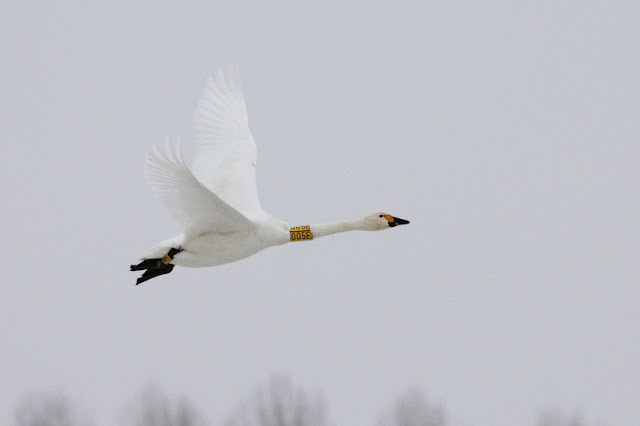I received some pictures of Bean geese from the UK in the past weeks. This autumn, Taiga Beans have been reported from other places than the regular two: Norfolk and the Slamman Plateau. In The Netherlands, only this individual has been reported this autumn.
 |
| Taiga Bean Goose / Anser fabalis fabalis - 22-2-2011 - Wassenaar (NL) |
For some years now, Taiga Beans do have my special interest. The identification of this species is very difficult, since the variation in both Tundra and Taiga Bean is far from clear. The Bean Geese complex has a very complicate taxanomical history. Recent MtDNA-studies by Ruokonen et al (2008, 2011) have shown that the Bean geese should be treated best as one species fabalis with the subspecies fabalis and rossicus, in stead of fabalis and rossicus as separate species. The latter was decided firstly by Sangster and Oreel (1996), based on Burgers et al (1991), but isn’t followed by all the taxonomists. Subspecies or species, to separate the two in the field is still a hard job for most birders. In the past decades, thousands of Taiga Beans were counted in The Netherlands by Leo van den Bergh and other geese specialists. Somebody told me Leo drove into Hungary and other eastern European countries to follow ringed Beans! I have never met him and only have read his publications. He described geese in terms of ‘black bills’, ‘eastern tundrabirds’, ‘yellow bills’, ‘johanseni geese’ et cetera. Tens of the extremely eastern middendorffi he reported. But no pictures of all those birds were made. No blame to Van den Bergh: someone had to face that difficult geese! For decades his opinion influenced the picture of the Bean geese in The Netherlands. Still, geese counters fill in ‘black billed Taiga Beans’ on their forms.
I think that the identification of Bean Geese is troubled partly by birders themselves. Why? … Since birders use the wrong approach while watching Bean Geese. I mean, searching for that individual which has a bigger, yellow bill among all that typical Tundra Beans. 100% you will get one in a flock of more than hundred, because bill colouration is highly variable in Tundra Bean Geese (cf. Burgers et al 1991).
The different approach was firstly described by Huyskens (1986): ‘Bean Geese have a group-identity’, he cited his friend Paul Maes. Groups of big, slender, predominantly yellow billed Beans will be Taiga Beans. And just that groups have become rare in The Netherlands since the ’80. So, when you observe Bean Geese: take your time. Observe the group carefully. Search for families, pairs and juveniles. Try to get a good look of the size and structure of the birds. Also examine their behaviour. In The Netherlands, Taiga Beans are very alert compaired to Tundra Beans. They prefer huge grasslands with some open water nearby. Tundra Beans prefer crop fields. If you think you have some good stuff, check:
- It are big, slender geese, in size approaching Greylag Geese. They are foraging quietly and often laying down while eating.
- The average of yellow in all the bills (on average more than 50% yellow in the bills): Taiga.
- The head profile is flat and Pochard-like. (Note that the profile depends on the activity of the goose.) It is a combination of a concave culmen, low base of the upper mandible, a straight and thin lower mandible, sometimes bowed a bit downwards towards the tip. The lower mandible isn’t bowed strongly, so the beak lacks the ‘typical grinning patch’ of a Tundra Bean.
- The slender necks have in some postures a crinckle at the base, which creates a kind of a swanlike impression.
Last November, James Lidster sent me this picture of an individual in the UK. So, what groupwise approach? Well, let's see if we can note something:
This must be a Taiga Bean, since Tundra never shows a bill lenght that is the same as the head. The structure and size is also better for Taiga, probably a female.
Here is the figure of Burgers et al (1991) wherein you can see the variability of the bill patterns.
 |
| February 2011, The Netherlands: compare the bills and head profile. The bill type is between B and C. |
Next week, some more pics of some families...













